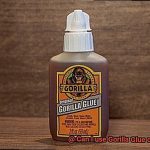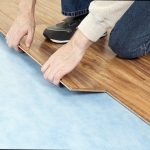Are you facing a dilemma of wanting to install a solid wood floor over a concrete subfloor? If so, you may be wondering whether it’s possible to glue solid wood to concrete. The good news is that it is indeed possible. However, this type of installation requires careful consideration and the use of appropriate materials to ensure success.
In this post, we’ll take an in-depth look at the topic of ‘Can solid wood be glued to concrete?’ We’ll explore the challenges involved in this type of installation and provide you with practical tips to help you achieve a flawless outcome. Whether you’re a DIY enthusiast or a professional contractor, this article will equip you with valuable insights on how to accomplish this task successfully.
We’ll discuss the best adhesives for bonding solid wood to concrete, as well as the recommended moisture content for the wood. We’ll also emphasize the importance of subfloor preparation for optimal results. Additionally, we’ll examine both the benefits and drawbacks of gluing solid wood to concrete, helping you make an informed decision about whether it’s the right option for your project.
So sit back, relax, and delve into our comprehensive exploration of whether solid wood can be glued to concrete. By the end of this article, you’ll have all the information you need to make a confident and knowledgeable decision on how to proceed with this question.
What is Glue?
Contents
Say hello to glue, also known as adhesive. It’s a substance that can be in liquid or semi-liquid form, made up of a mixture of chemicals that react and bind surfaces.
When it comes to gluing solid wood to concrete, the adhesive used plays a vital role in ensuring a strong and long-lasting bond. There are different types of glues available on the market that have their unique properties and usages. Some of the most commonly used types include white glue, polyurethane glue, epoxy glue, and cyanoacrylate glue.
White glue is a popular choice for woodworking projects since it dries clear, is easy to clean up, and has an impressive bond. Polyurethane glue is also widely used because it can bond different materials and has good water resistance. Epoxy glue is known for its high strength and durability, making it suitable for heavy-duty applications. Lastly, cyanoacrylate glue is perfect for small projects that require quick bonding.
However, when gluing solid wood to concrete, moisture plays a crucial role as concrete is naturally porous and can absorb moisture causing wood to warp or rot over time. Therefore, it’s essential that both the concrete surface and the wood are completely dry before applying any adhesive.
Another critical factor in creating a durable bond is preparing the surfaces correctly before applying the adhesive. This involves cleaning the concrete surface thoroughly and sanding or planing the wood to create a rough surface that enhances adhesion.
To ensure a strong and lasting bond between these two materials, using clamps or weights to hold the wood in place while the adhesive cures is crucial.
Can Solid Wood Be Glued to Concrete?
Fear not, because it is possible to glue solid wood to concrete. However, before diving into this DIY project, there are several crucial factors to consider.
Firstly, selecting the right adhesive is key to ensuring a strong and durable bond. Epoxy and polyurethane adhesives are popular choices due to their ability to withstand moisture and temperature changes. It’s crucial to choose an adhesive that is suitable for use with wood and concrete to ensure a reliable bond.
Secondly, proper preparation of both surfaces is essential. The concrete surface should be free of any debris or contaminants that could interfere with the bond, dry, and clean. Similarly, the wood should be clean, dry, and free of any existing finishes or coatings that could inhibit adhesion.
Lastly, the moisture content of the wood must be taken into account. Wood that is too dry or too wet can cause issues with adhesion and result in a weak bond. Therefore, ensuring the wood is properly conditioned before applying any adhesive is critical.
The Process for Gluing Solid Wood to Concrete
It’s a process that requires attention to detail and careful preparation, but with the right adhesive and technique, you can achieve a stunning result.
To begin, make sure the concrete surface is sparkling clean and free of any debris or dust. This can be achieved with a damp cloth or a vacuum cleaner. Allow the surface to dry completely before moving on to the next step.
Next, it’s time to apply the primer. A primer will help the glue adhere better to the concrete surface, but it’s important to choose the right one for your project. There are different types of primers available on the market, so be sure to select one that suits your needs.
After the primer has dried, it’s time to apply the adhesive. Use a notched trowel to ensure even coverage across the wood’s surface. Place the wood onto the concrete surface and press down firmly, ensuring that it is level and flush with the concrete. A spirit level or straight edge can help you achieve this.
Once the adhesive has dried, remove any leftover glue using a scraper or sandpaper. And finally, finish the wood as desired with staining, painting or varnishing.
It’s also important to note that moisture content in the wood should be considered when gluing solid wood to concrete. But with these steps and some attention to detail, you can achieve a strong and durable bond between solid wood and concrete.
Factors to Consider When Gluing Wood to Concrete
If so, it’s essential to consider several key factors to ensure a successful bond that will last for years to come.
Firstly, let’s talk about the type of wood being used. Solid wood is the best option as it provides a stable and robust surface for the adhesive to bond with. On the other hand, plywood or particleboard may not offer as strong a bond and may require additional reinforcement.
Next, it’s crucial to examine the type of concrete surface you’re working with. A smooth and clean surface is ideal for bonding, so it’s vital to clean and sand the concrete before applying the glue. Any roughness or debris on the surface can interfere with the adhesive’s ability to form a strong bond.

Choosing the right adhesive is another key factor. Epoxy, polyurethane, and cyanoacrylate adhesives are among the many options available. Each has its own characteristics and benefits, so it’s essential to choose an adhesive that suits both the type of wood being used and the conditions in which it will be applied.
Finally, it’s critical to consider the conditions under which you’ll be applying the glue. Temperature and humidity levels play a significant role in determining the strength and durability of the bond. Therefore, it’s essential to ensure that conditions are optimal for bonding before applying the adhesive.
Preparing the Surfaces Before Applying Adhesive
When it comes to bonding solid wood to concrete, surface preparation is the foundation of a strong and long-lasting bond. Taking the time to properly prepare the surfaces will ensure that your project won’t crumble like a sandcastle. In this post, we’ll guide you through the essential steps to prepare surfaces before applying adhesive.
Step 1: Cleanliness is Key
Before starting the bonding process, make sure both surfaces are clean and free of any dirt, dust or debris. A clean surface ensures that the adhesive will bond correctly and create a strong hold. Use a brush or vacuum cleaner to remove any debris from both surfaces before proceeding.
Step 2: Smooth Out the Concrete Surface
To achieve optimal results, ensure that the concrete surface is smooth and free of any bumps or rough spots. Use a leveler or sandpaper to smooth out any rough spots on the concrete surface. Smooth surfaces provide a better bonding surface for the adhesive, resulting in a stronger hold.
Step 3: Prepare the Wood Surface
After preparing the concrete surface, it’s time to focus on preparing the wood surface. Sand down the wood surface to remove any rough spots or bumps. A smooth surface ensures that the adhesive can bond correctly and create a strong hold.
Step 4: Apply the Adhesive
Now that both surfaces are clean and smooth, it’s time to apply the adhesive. Follow the instructions on the adhesive carefully and apply a generous amount of adhesive evenly over both surfaces. Ensure there are no gaps or air pockets for maximum bonding strength.
Clamps and Weights for Securing the Bond
When it comes to bonding solid wood and concrete surfaces, adhesive alone won’t cut it. To ensure a strong and long-lasting bond, clamps and weights are essential tools that should never be overlooked. As an expert in this field, I can assure you that these tools play a crucial role in the bonding process.
Clamps come in different shapes and sizes to cater to your specific needs. Edge clamps, for instance, are ideal for securing flat pieces of wood against a vertical surface. On the other hand, parallel-jaw clamps are adjustable and can apply pressure evenly across the surface of the wood. By holding the wood in place until the adhesive dries, clamps guarantee a permanent bond that will stand the test of time.
Weights are also valuable tools when bonding wood to concrete surfaces. They come in handy when attaching large or heavy pieces of wood to a vertical or horizontal surface. By placing weights on top of the wood, even pressure is applied, preventing any shifting or slipping during the bonding process.
It’s critical to note that proper positioning and sufficient pressure are crucial when using clamps and weights. The amount of pressure required will depend on the type of adhesive being used and the size and shape of the wood being attached. However, with these tools at your disposal, you can create a secure and long-lasting attachment that will remain strong for years to come.
KlELi8IaWo0″ >
Conclusion
In conclusion, solid wood can indeed be glued to concrete with the right adhesive and preparation. To achieve a strong bond, it’s essential to choose an appropriate adhesive that can withstand moisture and temperature changes. Options include white glue, polyurethane glue, epoxy glue, and cyanoacrylate glue.
Preparation of both surfaces is critical for optimal bonding conditions. The concrete surface should be clean and smooth, while the wood surface should be roughened by sanding or planing. This step enhances adhesion and ensures a long-lasting bond.
During the bonding process, clamps or weights should be used to apply even pressure for maximum strength. It’s also crucial to consider the moisture content of the wood before applying any adhesive.
By following these steps with attention to detail, gluing solid wood to concrete can result in a stunning outcome that lasts for years to come.






